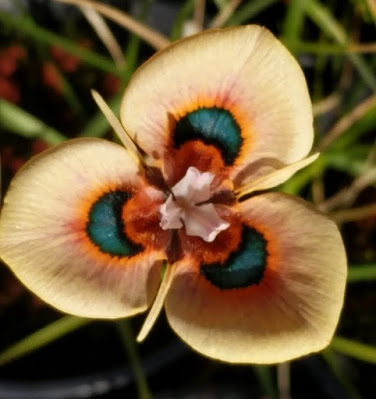Seed parent: Moraea tripetala
Pollen parent: Moraea neopavonia Summerfield form
MM 15-112a. What a weird, interesting looking plant. The tepals are a glowing peachy color, fading to almost white around the very dark blue eyes. There's also a faint yellow halo around each eye. This plant begs for some follow-on crosses.
Here's a slightly different sibling (I think). I haven't assigned a letter to it.
Sunday, June 14, 2020
Moraea MM 15-110
Seed parent: Moraea longiaristata with blue spots
Pollen parent: Moraea thomasiae
This is a very interesting little mystery. I've raised several hybrids with M. thomasiae as the apparent pollen parent, but in all cases the flowers have looked nothing like it. This one is clearly a hybrid of some sort, since at least one of them doesn't look exactly like its seed parent, but I can't see any M. thomasiae characteristics in either of them. If anyone has thoughts I'd welcome them.
Pollen parent: Moraea thomasiae
This is a very interesting little mystery. I've raised several hybrids with M. thomasiae as the apparent pollen parent, but in all cases the flowers have looked nothing like it. This one is clearly a hybrid of some sort, since at least one of them doesn't look exactly like its seed parent, but I can't see any M. thomasiae characteristics in either of them. If anyone has thoughts I'd welcome them.
MM 15-110a
Moraea MM 15-108
Seed parent: Moraea longiaristata with blue spots
Pollen parent: Moraea neopavonia Summerfield form
The 'Summerfield' variety of M. neopavonia has especially wide inner tepals, and you see that echoed in these flowers. Compare them to the very similar cross MM 15-105.
MM 15-108a
MM 15-108b
MM 15-108c
Pollen parent: Moraea neopavonia Summerfield form
The 'Summerfield' variety of M. neopavonia has especially wide inner tepals, and you see that echoed in these flowers. Compare them to the very similar cross MM 15-105.
MM 15-108a
MM 15-108b
MM 15-108c
Moraea MM 15-105
Seed parent: Moraea neopavonia with blue eye
Pollen parent: Moraea longiaristata with blue spots
As often happens, the look of M. neopavonia dominates this cross, without any hint of the blue dots fro the pollen parent. It'll be interesting to see if the dots emerge in next-generation crosses made with these plants. For a similar cross see MM 15-108.
MM 15-105a. There's an interesting jagged edge to the eyes.
MM 15-105b
Pollen parent: Moraea longiaristata with blue spots
As often happens, the look of M. neopavonia dominates this cross, without any hint of the blue dots fro the pollen parent. It'll be interesting to see if the dots emerge in next-generation crosses made with these plants. For a similar cross see MM 15-108.
MM 15-105a. There's an interesting jagged edge to the eyes.
Saturday, June 6, 2020
Moraea MM 15-90
Seed parent: Moraea villosa form H
Pollen parent: MM 11-72a (M. tulbaghensis X villosa)
The orange color of M. tulbaghensis usually dominates when you cross it with M. villosa. This is one of a series of crosses in which I combined one of those tulbaghensis-villosa hybrids with a species M. villosa, to see if I'd get a wider variety of colors.
MM 15-90a. And the answer is...kinda'. This is a purpley flower with some orange undertones.
GK 1529. Same cross, grown by Garry Knipe.
Pollen parent: MM 11-72a (M. tulbaghensis X villosa)
The orange color of M. tulbaghensis usually dominates when you cross it with M. villosa. This is one of a series of crosses in which I combined one of those tulbaghensis-villosa hybrids with a species M. villosa, to see if I'd get a wider variety of colors.
MM 15-90a. And the answer is...kinda'. This is a purpley flower with some orange undertones.
MM 15-90b
Subscribe to:
Posts (Atom)

















